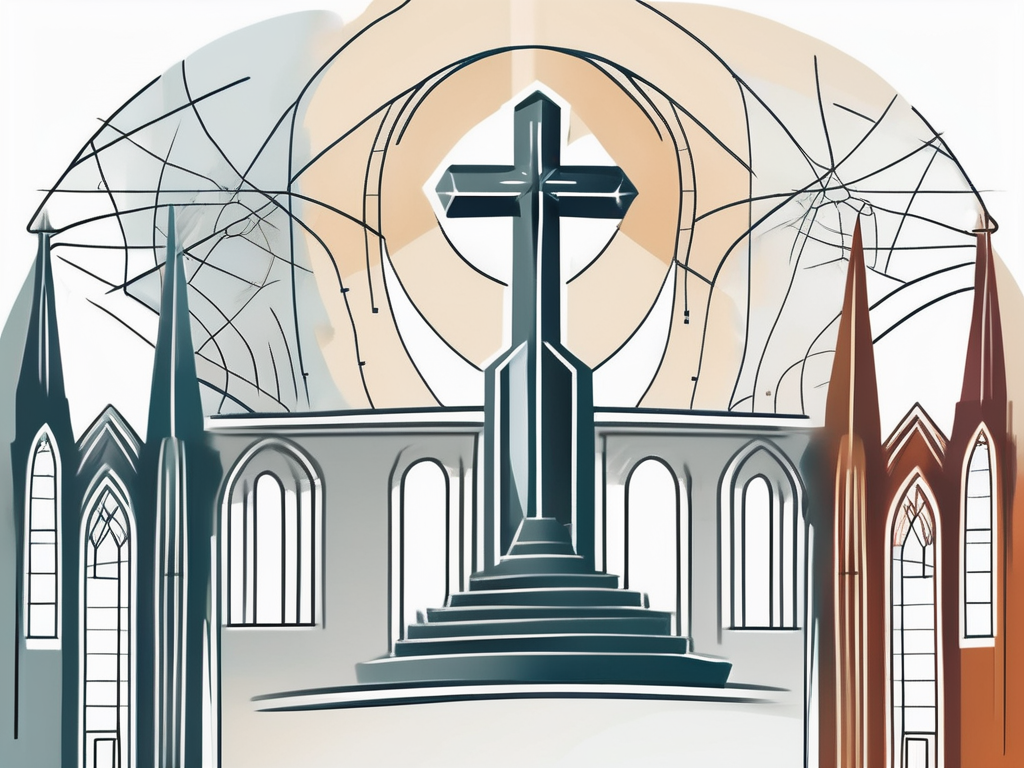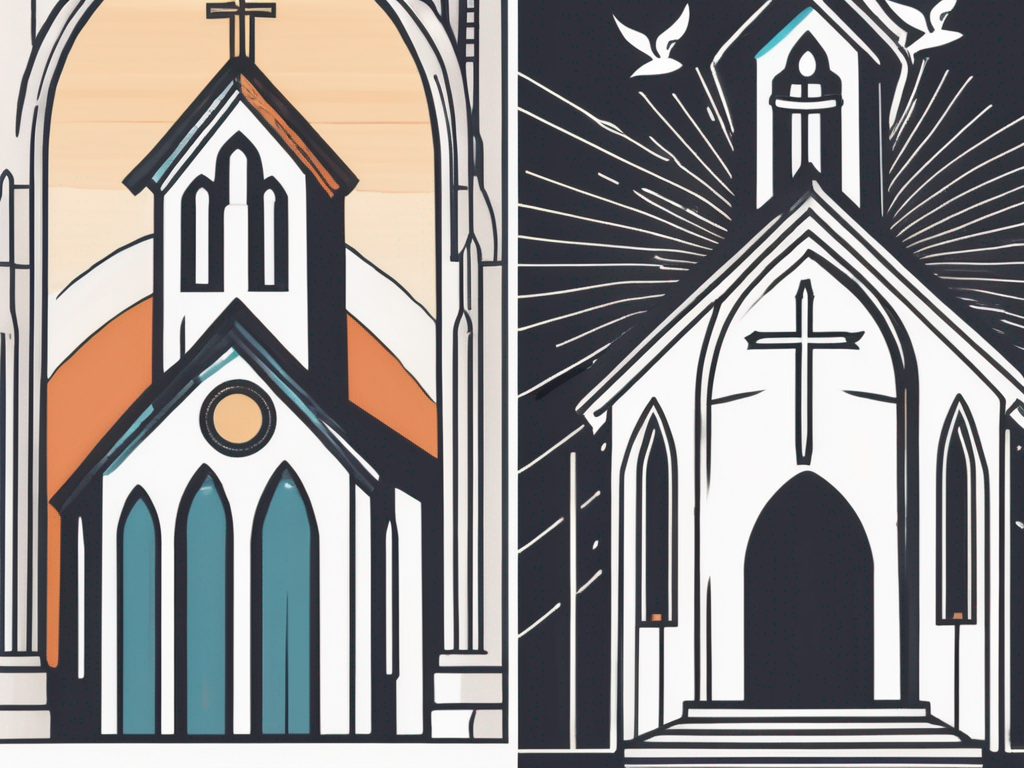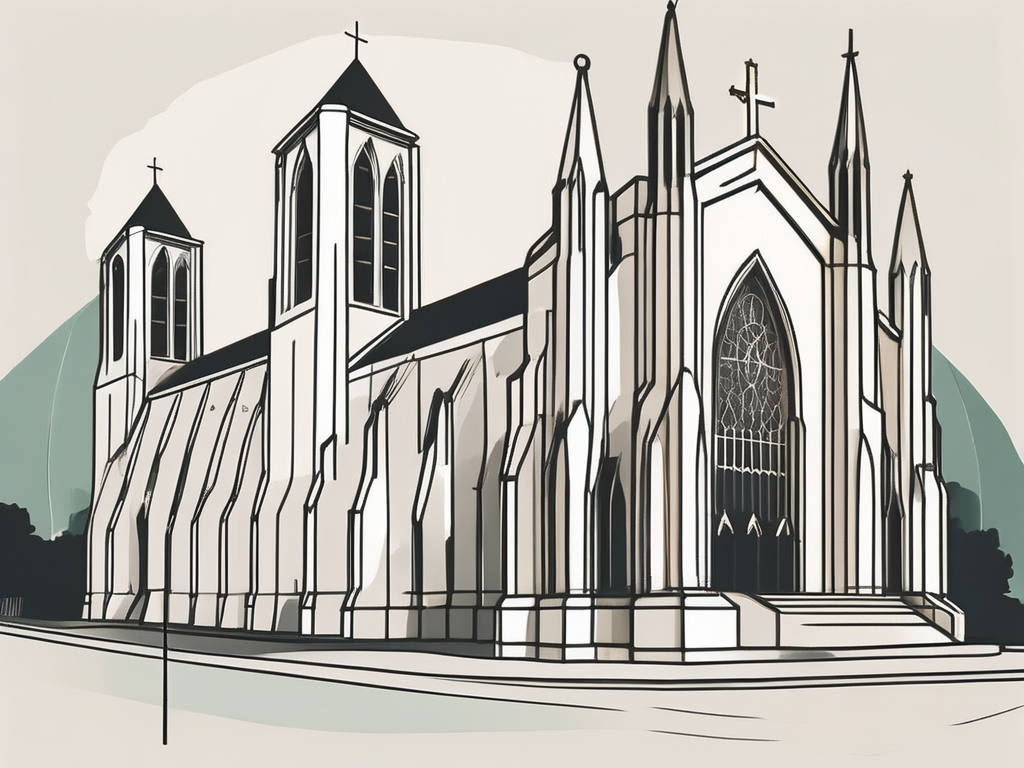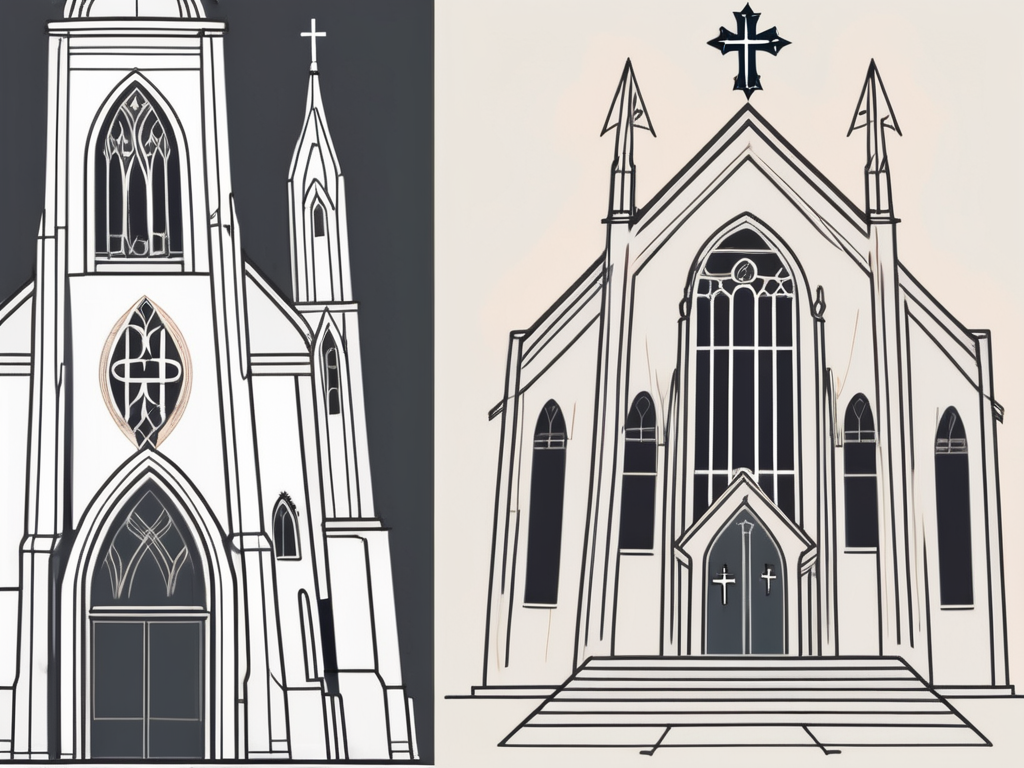When it comes to Christianity, there are various denominations that have their own distinct beliefs, practices, and traditions. Two of the most prominent denominations are Protestantism and Methodism. While they share some similarities, there are also key differences that set them apart. In this article, we will explore the origins, core beliefs, worship styles, roles of the church and clergy, as well as sacraments and rituals, to better understand the differences between Protestantism and Methodism.
The Origins of Protestantism and Methodism
Protestantism and Methodism both trace their roots back to the Reformation in the 16th century. This movement aimed to reform the Roman Catholic Church, which had grown corrupt and strayed from its original teachings. Led by Martin Luther, John Calvin, and other reformers, Protestantism emerged as a broad term encompassing various denominations, including Methodism.
The Birth of Protestantism
Protestantism began in Germany when Martin Luther famously nailed his Ninety-Five Theses to the door of the All Saints’ Church in Wittenberg in 1517. Luther’s actions sparked a widespread movement challenging the authority of the Catholic Church and emphasizing salvation by faith alone.
This pivotal moment in history ignited a wave of religious and social change across Europe. The ideas put forth by Luther and other reformers resonated with many who felt disillusioned by the practices of the Catholic Church. As the movement gained momentum, it spread to other countries, including Switzerland, where John Calvin played a significant role in shaping Protestant theology.
Protestantism, with its emphasis on individual interpretation of the Bible and the priesthood of all believers, offered a radical departure from the hierarchical structure of the Catholic Church. The movement attracted a diverse range of followers, from peasants seeking spiritual liberation to nobles seeking political autonomy from the Pope.
As Protestantism took root in different regions, it diversified into various denominations, each with its own theological nuances and practices. Lutheranism, Calvinism, Anglicanism, and many others emerged as distinct branches of the Protestant tree, each contributing to the rich tapestry of Christian traditions.
The Emergence of Methodism
Methodism, on the other hand, originated in England in the 18th century as a revival movement within the Church of England. It was founded by John Wesley, along with his brother Charles Wesley. The Methodists aimed to revitalize the faith of the people and emphasized personal piety and a methodical approach to Christian living.
John Wesley, a passionate preacher and theologian, sought to bring about spiritual renewal in a society plagued by social inequality, poverty, and moral decay. He believed that true faith should be expressed through acts of charity, social justice, and personal holiness. Wesley’s preaching style, characterized by its fervor and emphasis on personal experience, attracted large crowds and ignited a revival movement that would later become known as Methodism.
Methodism quickly spread beyond the borders of England, finding fertile ground in the American colonies. The Methodist movement played a significant role in shaping the religious landscape of the United States, particularly during the Great Awakening in the 18th century. Methodist preachers traveled extensively, delivering impassioned sermons to eager listeners, and establishing vibrant communities of believers.
One of the key features of Methodism was its emphasis on small group meetings, known as class meetings or societies. These gatherings provided a space for individuals to share their spiritual journeys, offer support to one another, and hold each other accountable in their pursuit of holiness. The Methodist movement also placed a strong emphasis on education, establishing schools and colleges to equip its members with knowledge and skills.
Over time, Methodism evolved into a distinct denomination with its own organizational structure and theological distinctives. It became known for its commitment to social justice, its focus on personal transformation, and its vibrant worship practices. Today, Methodism continues to be a significant presence in the global Christian community, with millions of adherents around the world.
Core Beliefs and Doctrines
When exploring the rich tapestry of Christian beliefs, it is fascinating to observe the similarities and differences between Protestantism and Methodism. While both traditions share fundamental Christian beliefs, they also have distinct doctrinal differences that shape their unique identities.
Fundamental Protestant Beliefs
Protestants, as a whole, hold certain core beliefs that form the foundation of their faith. One of the central tenets of Protestantism is the belief in the authority of Scripture. Protestants affirm the Bible as the ultimate source of religious truth, viewing it as divinely inspired and infallible. This conviction leads Protestants to approach the Scriptures with reverence and to seek guidance and wisdom from its pages.
Another fundamental belief within Protestantism is the doctrine of justification by faith alone. This doctrine emphasizes that salvation comes through faith in Jesus Christ and not through good works. Protestants firmly believe that humans are justified, or made right with God, solely through faith in Jesus’ sacrificial death and resurrection. This understanding highlights the grace of God and the sufficiency of Christ’s work on the cross for the redemption of humanity.
Essential Methodist Doctrines
Methodism, a branch of Protestantism, has its own unique set of doctrines that distinguish it from other Protestant traditions. One of the key doctrines embraced by Methodists is the Wesleyan Quadrilateral. This approach to theology combines four sources of authority: Scripture, tradition, reason, and experience. Methodists believe that these four elements work together harmoniously to guide their understanding of God, faith, and the Christian life.
Within Methodism, there is a belief in the possibility of Christian perfection, often referred to as “entire sanctification.” This doctrine asserts that believers can experience a life free from willful sin. Methodists hold that through the work of the Holy Spirit, individuals can attain a state of holiness in which their hearts are fully transformed by God’s grace. This pursuit of holiness is seen as a lifelong journey, marked by continual growth in love for God and others.
It is important to note that while these doctrinal differences exist between Protestantism and Methodism, there is also a shared commitment to the central truths of the Christian faith. Both traditions affirm the divinity of Jesus Christ, the reality of sin, the need for salvation, and the hope of eternal life through faith in Christ. These shared beliefs serve as a unifying force within the broader Christian community, while the distinct doctrines of each tradition contribute to the beautiful diversity of Christian thought and practice.
Worship Styles and Practices
When exploring the differences between Protestantism and Methodism, one cannot overlook the distinct worship styles and practices that characterize these two religious traditions. These differences not only reflect the unique theological perspectives of each tradition but also shape the overall worship experience for their respective congregations.
Protestant Worship Traditions
Protestants, as a whole, encompass a wide range of worship traditions that cater to the diverse needs and preferences of their congregations. From traditional liturgical services to contemporary worship, Protestant churches offer a variety of worship styles to engage their members.
In traditional Protestant worship services, you will often find a structured order of worship that includes elements such as hymns, prayers, sermons, and sacraments like baptism and communion. These services are designed to follow a specific liturgical pattern, which may vary depending on the denomination. The use of formal liturgy creates a sense of reverence and continuity, connecting worshippers to the historical roots of their faith.
On the other hand, contemporary Protestant worship services take a more informal approach, incorporating modern music styles, multimedia presentations, and interactive elements. These services often feature praise bands or worship teams leading the congregation in singing contemporary Christian songs. The aim is to create a vibrant and engaging worship experience that resonates with the younger generation and those seeking a more casual and relaxed atmosphere.
Methodist Worship Customs
Methodists, a branch of Protestantism, have their own unique worship customs that distinguish them from other Protestant denominations. Methodists typically gather for worship in churches referred to as chapels or sanctuaries, which serve as sacred spaces for communal worship.
Methodist worship services are characterized by a strong emphasis on congregational participation and fervent expressions of faith. Central to their worship experience are the singing of Wesleyan hymns, which hold deep historical and theological significance for Methodists. These hymns, composed by the movement’s founder, John Wesley, are known for their rich theological content and heartfelt expressions of devotion.
In addition to congregational singing, Methodist worship services also include communal prayers, both spoken and silent, where worshippers come together to lift up their joys, concerns, and intercessions. The sermon, delivered by a minister or lay preacher, plays a vital role in Methodist worship, providing spiritual guidance, biblical teaching, and practical application for daily living.
Furthermore, Methodists celebrate the sacraments of baptism and communion as integral parts of their worship practices. Baptism symbolizes the initiation into the Christian faith, while communion, also known as the Eucharist or Lord’s Supper, represents the remembrance of Christ’s sacrifice and the unity of believers.
Overall, Methodist worship customs seek to foster a sense of community, spiritual growth, and personal connection with God. Through their vibrant and participatory worship services, Methodists aim to create an environment where individuals can encounter the divine and deepen their faith journey.
The Role of the Church and Clergy
Both Protestantism and Methodism have their own perspectives on the role of the church and clergy. However, before delving into their respective views, it is important to understand the historical context in which these perspectives emerged.
The Protestant Reformation, which began in the 16th century, challenged the authority of the Catholic Church and sparked a wave of religious and theological reform across Europe. One of the key principles that emerged from this movement was the concept of the “priesthood of all believers.”
The Protestant View on Church Authority
Protestants believe in the “priesthood of all believers,” where each believer has direct access to God and can approach Him without the need for intermediaries. This idea was revolutionary at the time, as it challenged the Catholic Church’s monopoly on religious authority and emphasized the individual’s personal relationship with God.
According to the Protestant perspective, the church is seen as a community of believers rather than a hierarchical institution. While some Protestant denominations, such as Lutheranism, maintain a more structured approach with ordained clergy, the overall emphasis is on the equality and autonomy of all believers.
Within the Protestant tradition, there is a diversity of views on the role of clergy. Some denominations emphasize the importance of ordained ministers as spiritual leaders and teachers, while others adopt a more egalitarian approach, where all members of the congregation are encouraged to actively participate in the life of the church.
The Methodist Perspective on Clergy
Methodism, a branch of Protestantism that emerged in the 18th century, shares many of the core principles of the wider Protestant tradition. However, it also has its own distinct perspective on the role of the clergy.
Methodists, while also valuing the importance of all believers, have a more structured approach to church leadership. They recognize the clergy as ordained leaders who are responsible for shepherding and guiding the congregation. This recognition stems from John Wesley’s belief in the necessity of trained and accountable ministers to ensure the spiritual growth and well-being of the Methodist movement.
In Methodism, the clergy undergo a process of education and ordination, which includes theological training and a commitment to upholding the teachings and values of the denomination. The clergy are seen as spiritual guides, providing pastoral care, preaching the Word of God, and administering the sacraments.
However, it is important to note that Methodism also emphasizes the active participation of all believers in the life of the church. While the clergy have specific roles and responsibilities, they are not seen as the sole mediators between God and the congregation. Methodists believe in the priesthood of all believers and encourage laypeople to engage in ministries, such as teaching, evangelism, and social justice, alongside the clergy.
Overall, while both Protestantism and Methodism have their own perspectives on the role of the church and clergy, they share a common commitment to the priesthood of all believers and the importance of the Christian community. These perspectives continue to shape the practices and beliefs of believers within these traditions, fostering a sense of unity and diversity in the wider Christian landscape.
Sacraments and Rituals
Sacraments and rituals hold significant meaning in both Protestant and Methodist practices, but their understanding and observance differ.
Protestant Sacraments and Their Significance
Most Protestants recognize two sacraments: baptism and communion. Baptism symbolizes the believers’ identification with Christ’s death and resurrection, while communion commemorates the Last Supper and the sacrifice of Jesus Christ.
Methodist Rituals and Their Meaning
In addition to baptism and communion, Methodists also practice other rituals such as confirmation, marriage, and anointing of the sick. These rituals hold symbolic meaning and serve as important milestones in one’s faith journey.
In conclusion, Protestantism and Methodism share a common heritage in the Reformation. However, their distinct origins, core beliefs, worship styles, views on church authority, and observance of sacraments and rituals set them apart. By understanding these key differences, we can appreciate the diversity within Christianity and engage in meaningful conversations that promote unity and understanding among believers.












